
New techniques for studying orcas have been credited with breakthroughs in reproductive and developmental research. Drones and hormone-sniffing dogs are helping scientists connect declines in food supply with low birth rates and poor health. Update: The research described in this 2016 article has now been published in the 6/29/17 issue of the journal PLOS ONE.

Pregnancy is an uphill battle for fish-eating killer whales of the Salish Sea, according to new hormonal studies, which show a high miscarriage rate among expectant orca moms.
In addition to the new and intriguing hormonal studies, researchers taking photos from unmanned aircraft have been able to monitor changing body conditions of the killer whales — including females as they progress through pregnancy.
Among the Southern Residents of the Salish Sea, about 65 percent of the pregnancies are ending early with miscarriages, according to research led by Sam Wasser, director of the Center for Conservation Biology at the University of Washington. And of those miscarriages, nearly one-third take place during the last stage of pregnancy.
“A pregnant female is feeding for two. ... She is running out of food. ...”
That’s an awfully high level for mammals — especially orcas, which carry their unborn offspring for 17 or 18 months, Wasser said during a presentation at the Salish Sea Ecosystem Conference in April. “Late abortions are very rare in mammals, because they are dangerous for the animal.”
Just how dangerous was revealed in December 2014, when an 18-year-old Southern Resident orca named “Rhapsody” was found dead off Vancouver Island with a late-term fetus still in her uterus. An examination confirmed that the decomposing fetus became lodged in her body. That likely led to a septicemia, a severe bacterial infection that probably led to her death.
Killer whale advocates were shocked at Rhapsody’s death, which came near the beginning of her reproductive life. It was a loss for the entire Southern Resident community, because this young female had the potential to add several babies to the dwindling population, listed as endangered under the Endangered Species Act.
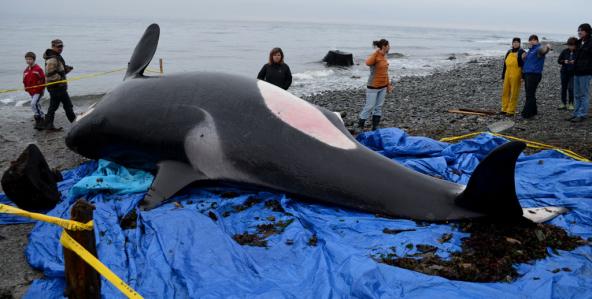
Rhapsody, designated J32, had been pregnant at least twice before, but those pregnancies ended in miscarriages, according to Wasser, who learned to identify pregnant females by studying hormone levels in their feces. One question will forever remain unanswered: Would Rhapsody and her offspring still be alive if environmental conditions in the Salish Sea had been better?
Before Wasser’s studies, nobody had a reliable way to tell when an orca was pregnant, so miscarriages generally went undetected. Long-time researchers, such as Ken Balcomb of the Center for Whale Research, have reported on females that appeared to be pregnant by noting their increasing girth, but such observations come months into the pregnancy. Now, Wasser says hormones can reveal the stage of pregnancy as well as stresses affecting the whales.
Meanwhile, a separate team of researchers working with small unmanned aircraft, commonly called drones, are reporting that they can detect pregnancies by taking high-resolution photographs to measure body length and width to within an inch or two. Without disturbing the whales, the researchers can identify subtle changes in the animals, including signs of poor health, according to Canadian researcher Lance Barrett-Lennard of Vancouver Aquarium speaking at the Salish Sea conference.
Together, the hormonal and drone studies, along with other research, are confirming what marine mammal scientists have been suggesting for years: When food is adequate during pregnancy, female orcas are more likely to carry their unborn calves to term, thus adding to the population. But when food is scarce, some babies are never born or else die within days of birth.
“We’ve moved toward some great sophisticated technology,” said Lynne Barre, who heads NOAA’s Protected Resources Division in Seattle and oversees recovery efforts for the endangered Southern Residents. “These great technologies combined can tell us more than any one method can … such as when and where food limitations might be affecting their health and reproduction.”
As much as death has been linked to a lack of salmon among the killer whales, birth is connected to times of improved salmon runs. During last year’s so-called “baby boom,” an unprecedented nine calves were born between December 2014 and January 2016, following an upturn in Chinook numbers along the West Coast. All but one of these baby-boom calves are believed to be still alive.
Hormonal links to health
The findings by Wasser and his associates are the result of testing hundreds of fecal samples, which were collected by following killer whales in a boat. Tucker, a black Labrador retriever mix, has become a celebrity for his keen ability to sniff out whale scat on the water and direct the boat to the correct spot using subtle movements of his head and body.
From the fecal samples located by Tucker, DNA can be extracted to identify individual whales. Then, by testing various excreted hormones, the researchers can determine a whale’s level of stress, nutritional condition, metabolic rate and reproductive status.
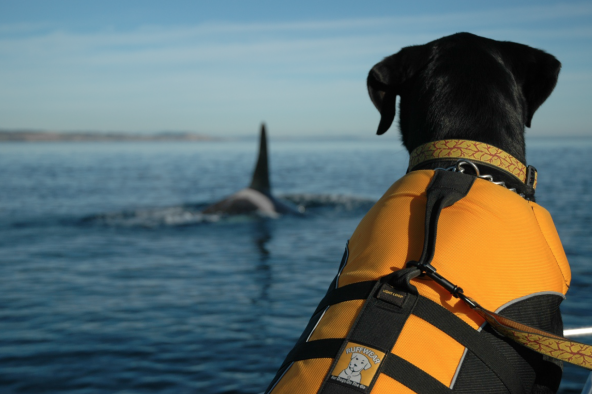
For example, when progesterone levels are high, one can conclude that the female is pregnant, Wasser said. Testosterone, which increases slowly during pregnancy, can be used to determine the stage of fetal growth.
Wasser’s study involved fecal samples from nearly three dozen pregnant females from 2007 through 2014. About a quarter of all the pregnancies resulted in a late-term miscarriage or else a birth in which the calf died before being noticed by human observers.
Reasons for the high rate of miscarriages were explored by looking at other hormones excreted by the pregnant females. They include thyroid hormone, which controls metabolism, and glucocorticoids, which rapidly boost glucose levels to help an animal confront various challenges, ranging from hunger to confrontation with an enemy.
For most orcas, thyroid hormones decline when food is scarce, slowing their metabolism and conserving their energy reserves. When food is abundant, the thyroid hormones keep the body in a highly functioning state.
When the whales return to the Salish Sea each spring, fecal samples for most orcas show a relatively high level of thyroid hormone, which means the whales must have been finding food in the ocean. It is likely that they were intercepting Chinook salmon returning to the Columbia River, Wasser said.
The story is somewhat different for a portion of the pregnant females coming into the Salish Sea, he noted. That group arrives with low thyroid hormone levels, and these are the ones most likely to have a late-term miscarriage. For some reason, they were not finding enough food to keep themselves and their unborn calves at highly functioning levels.
Generally for all the whales coming back to the Salish Sea, their high thyroid levels begin to drop upon their arrival, meaning they are not finding enough food. Many years ago, the whales may have been able to hunt for large runs of early-spawning spring Chinook, but those runs have declined drastically over the years. Now, the whales are often forced to wait for later runs of Chinook to the Fraser River and northern Puget Sound before they get enough to eat. Chinook salmon are listed as threatened under the Endangered Species Act.
Pregnant females who come into the Salish Sea with low thyroid levels are in trouble, Wasser said. Their fetus needs adequate thyroid hormones for proper brain growth, but the expectant moms are not getting enough food to provide for them.
“They don’t arrive in good condition, and they don’t ever catch up,” Wasser said.
Toxic chemical effects
Compounding the problem for killer whales, especially pregnant females, are polychlorinated biphenyls (PCBs) and other toxic chemicals embedded in their blubber, according to studies by Wasser’s colleague Jessica Lundin, now with NOAA. The whales use this stored fat as an emergency energy supply. When a pregnant female cannot find enough fish, she begins to burn her fat supplies, releasing PCBs into her bloodstream. One of the many effects of PCBs is to depress thyroid hormones.
“A pregnant female is feeding for two,” Wasser said. “She is running out of food and dumping toxins. Her fetus desperately needs thyroid hormone for brain growth, but it’s not there.”
Ultimately, the fetus may not survive, and the ordeal also takes a heavy toll on the mother, who may not have enough energy reserves to make it through the winter.
The internal survival strategy is far more favorable for the males and those females that aren’t pregnant. Without the burden of a growing fetus, their thyroid glands adjust to the available food supply and aid in building up fat reserves for the winter.
When it comes to PCBs and other contaminants, males accumulate toxic chemicals for a lifetime. Although PCBs have been shown to have multiple hormonal effects on mammals, the precise effects on the killer whales have not yet been identified. Still, blubber samples taken from the Southern Residents show toxic levels high enough to create immune and reproductive problems, based on toxic studies of seals, otters and mink.
Like males, females accumulate toxic chemicals throughout their lives — with one critical exception. When a female becomes pregnant, she begins transferring contaminants to her unborn fetus. If the baby survives, the lactating mother will transfer even more toxics through her fat-rich milk, often leaving the calf with a higher concentration of PCBs than the mom.
Wasser and his associates spent considerable time developing and testing procedures for collecting and measuring toxic chemicals in killer whale feces. The result is that chemical concentrations obtained from fecal samples are fairly consistent with those obtained from blubber samples. And hundreds of fecal samples can be obtained without disturbing the animals, whereas getting a blubber sample requires moving in close to the whales and firing a dart that takes out a bit of their skin.
Aerial photogrammetry
Killer whales are literally shaped by how much food they eat, according to Barrett-Lennard, a longtime research scientist currently involved in the new drone program. When salmon are abundant and a young whale can get enough to eat, it will grow to become a larger adult, he explained. Those who grow up during a food shortage turn out to be smaller animals, he added, referring to a report by Holly Fearnbach of NOAA’s Southwest Fisheries Science Center.
The idea of carefully measuring each killer whale to assess its health and monitor its growth began to take hold a decade ago among whale researchers. In 2008, a group of scientists took to the air in a chartered helicopter to take photographs for measuring the length and girth of Southern Residents. The research team was led by John Durban, who worked for the Center for Whale Research at the time.
The researchers took more than 2,800 useable images during 10 flights over the whales. At 1,000 feet over the animals, measurements were accurate within about 1.5 inches. Besides length, measurements included breadth and head width — breadth measured at the front base of the dorsal fin and head width measured just behind the cranium. Using photos as a measuring tool is called photogrammetry.
One whale, a 23-year-old female, had the thinnest head of all the adult females. Researchers on a research boat also said she appeared to be in poor condition. The day that her measurements were taken from the helicopter was the last day she was ever seen.
From that study, the scientists concluded that aerial photos could be used not only to monitor the growth of whales but to assess their health throughout life. By chance, small, quiet and lightweight drones were coming on the market to do what helicopters could do, but at a fraction of the cost.
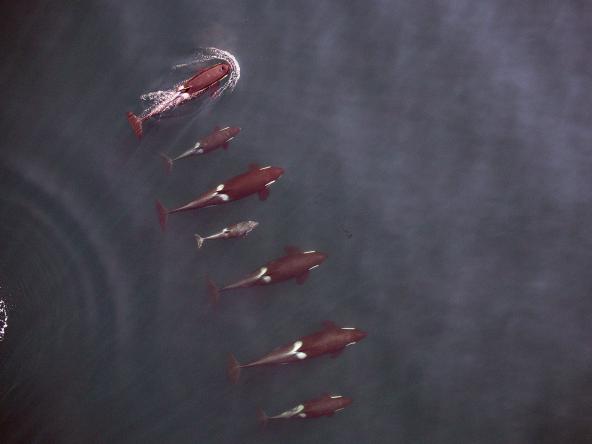
Now, the researchers use a remote-controlled aircraft with six horizontal blades, called a hexacopter, which is paired up with a high-resolution camera. Photos are taken from about 100 feet — high enough that the whales never even know they are being watched. Final measurements are taken at 20 points along the length of each whale.
“We now have a quantitative measure of how the whales are changing over time, as they advance through different ages and reproductive conditions,” said Durban, who now works in NOAA’s Southwest Fisheries Science Center and teams up with Barrett-Lennard and Fearnbach to conduct the photogrammetry studies.
“Sam (Wasser) can detect pregnancies from fecal hormones, and we can detect pregnancies reliably from the air,” Durban said. “Together, these two approaches provide a lot of (analytical) power.”
By photographing pregnant females over time at SeaWorld in California, the researchers in the Salish Sea are now able to estimate the stage of pregnancy once the orca moms begin showing, which is a few months into gestation. When a pregnant female gets smaller in the midsection, it generally means she has given birth or had a miscarriage.
Last September, the team was able to use the hexacopter to photograph every living orca within the Southern Resident community. In May, 34 whales that were in the San Juan Islands at the time were caught on film. Another round of photos is scheduled for September.
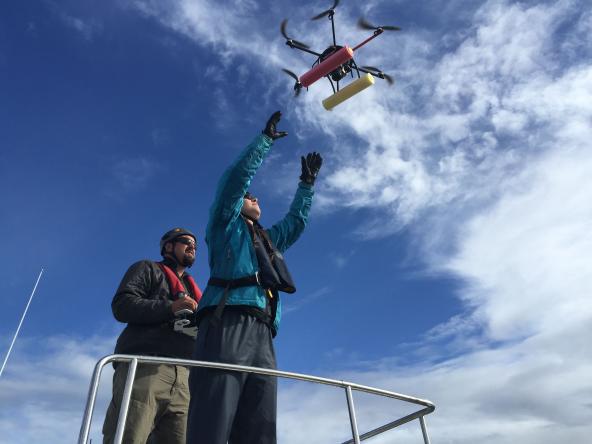
“The analysis is still underway,” Durban said, “but we will be able to look at how the whales are doing from year to year and season to season.”
Similar work is being done on the Northern Resident orcas of British Columbia, which also depend on Chinook salmon for the majority of their diet.
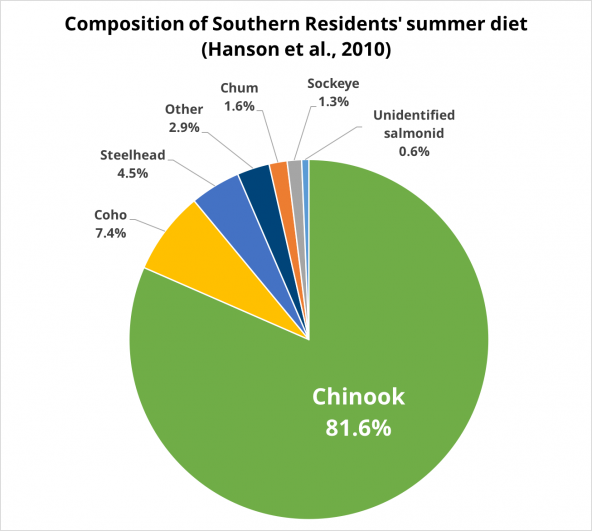
When salmon are in decent numbers, the whales take on weight. One youngster shown in photographs over a two-year period had nearly caught up in length to his older siblings.
“Each individual has a different shape,” Durban said. “The question is how those individuals change over time. The whales are going to tell us how they relate to the salmon runs. We might not be able to measure precisely the number of fish that are available to the whales, but we are measuring the results.”
Consequently, natural resource managers may begin to understand which salmon runs are most important at key times to the whales and focus efforts on protecting and restoring those particular runs.
One goal is to create a body index, or score, based on the condition of each whale. A declining score, on average, could indicate that the whales are in trouble. How that might translate into management actions is something to be explored.
Next steps
A variety of experts involved in killer whale studies are working together to develop a health assessment for each of the 80+ orcas in the three Southern Resident pods. Sharing information as soon as it is available could help researchers understand their medical problems and possibly allow for intervention and treatment at some future date.
Since adequate food availability seems to be a key issue, one group of researchers is studying all the known predators that eat salmon — including seals and sea lions — to learn how the whales are affected, said Barre. The effects on orcas from hatchery operations, salmon fishing and habitat are all under investigation, she added.
Many of the new findings will be included in a five-year status report on the Southern Residents, Barre said. The report also will re-examine the risk of extinction and consider whether actions proposed to help the whales have been carried out. The report is expected by the end of this year.
Next year, long-awaited decisions about whether and how to expand “critical habitat” for the killer whales should be released for public review, Barre said. Designated habitat currently covers much of the Salish Sea but not the outer coast, even though researchers have learned that the whales spend much of their time in the ocean.
Beyond the question of where the whales travel and where they find food in the ocean, the determination of critical habitat must account for other issues, such as effects of the designation on the economy, military needs for national security and tribal interests.
One thing is becoming more certain as time goes on, experts agree. The fate of the Southern Residents is closely tied to the abundance of salmon. As salmon runs decline, the whales spend less and less time in large social groups. Instead, they break up into smaller family groups and travel farther in search for food. That can affect behaviors, from mating to caring for young ones in the population.
Despite a similar preference for Chinook salmon, Northern Resident killer whales of British Columbia have somewhat different population characteristics. A Northern Resident female, for example, will bear an average of one additional calf over her lifetime compared to Southern Residents.
Many would agree that Chinook salmon are the key to the future. “If you want to fix the system,” Wasser says, “you need to bring the food back.”

